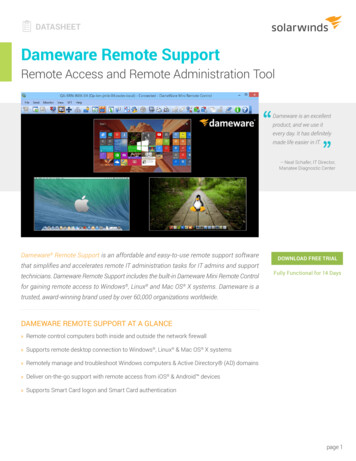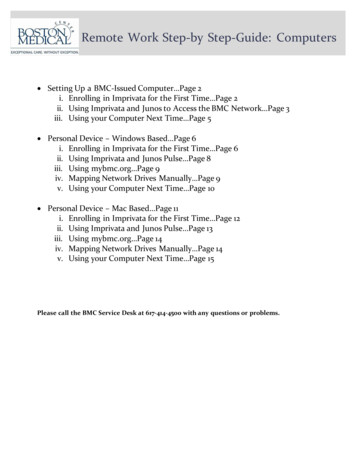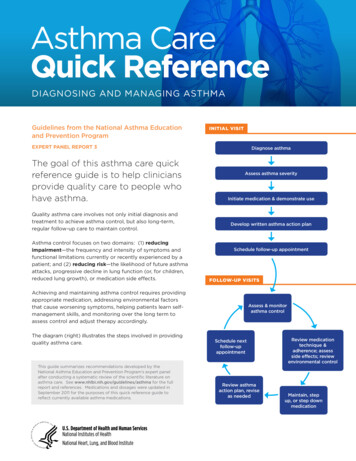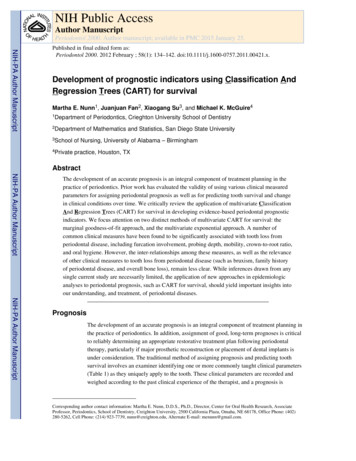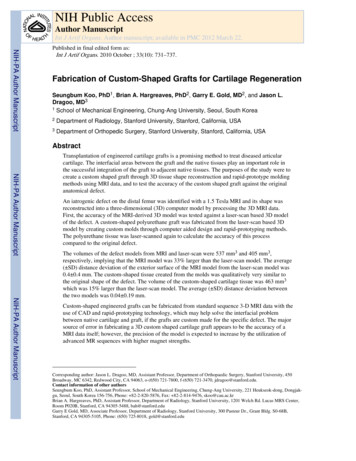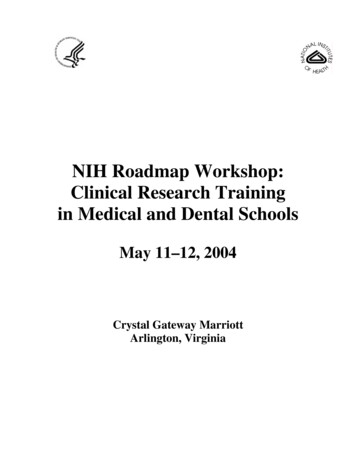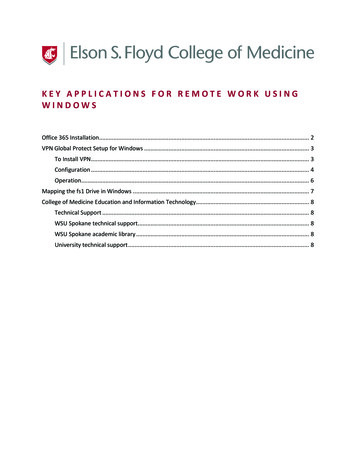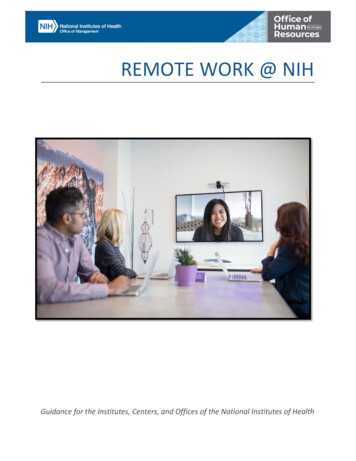
Transcription
REMOTE WORK @ NIHGuidance for the Institutes, Centers, and Offices of the National Institutes of Health
ContentsIntroduction To Remote Work. 3Supervisory Considerations For Remote Work. 4Employee Considerations For Remote Work. 5Process For Initiating A Remote Work Arrangement . 6Best Practices And Lessons Learned . 7Communication Tools And Technology . 9Templates. 112
INTRODUCTION TO REMOTE WORKRemote Work is an increasingly common arrangement at not only the NIH but across federalgovernment and in the private sector. The considerations, process, and templates contained inthis document are guidance only, and are not official policy. The information herein seeks toanswer questions members of the NIH community may have about remote work and to assistboth supervisors and employees in establishing successful remote work arrangements.What Is Remote Work?An arrangement in which an employee’s official duty station is an approved alternativeworksite. The approved alternative worksite may be inside or outside the local commuting areaof the Agency worksite and is typically, although not always, the employee’s residence.Remote work is not an employee entitlement, but rather a workplace flexibility that may beavailable dependent on a variety of factors and with supervisory approval.Synonyms For Remote WorkVirtual Worker, Full-time Teleworker, Permanent TeleworkerWhat Is The Difference Between Telework And Remote Work?An employee who has a remote work arrangement permanently works from an alternativeworksite that is not a NIH owned or leased facility. An employee who has a teleworkarrangement works from home on a regular or ad hoc basis but reports to the agency’s officialduty station at least once a week/two days a pay period 1.This distinction is important because a remote worker’s official duty station is the alternativeworksite, and they receive locality pay based on that duty station. Remote workers may still beeligible for telework with supervisory approval, if they wish to regularly or on an ad hoc basiswork from an additional alternate site (i.e. a co-working arrangement). Travel back to theirwork unit's primary worksite is covered by travel policy.What Are The Benefits Of Remote Work?Remote Work is a workplace flexibility that can help NIH retain employees who wouldotherwise leave their current positions. One of the most common reasons employees request aremote work arrangement is due to family responsibilities – for instance, their spouse is beingrelocated for work. Many are thrilled to learn they are able to continue working for the agency.Establishing a remote work arrangement also benefits the agency, as it eliminates the need torecruit and train a replacement. Remote workers also report improved work/life balance,feeling more productive, and having an increased sense of loyalty to the agency.“Work is what we do, not where we are.”- General Services Administration1See OPM Fact Sheet: Official Worksite for Location-Based Pay Purposes.3
SUPERVISORY CONSIDERATIONS FOR REMOTE WORKGeneral Can the employee’s set of job duties be accomplished remotely?Has the employee demonstrated that they are able to work independently with littlesupervisory oversight?Does the employee meet any IC/Office minimum PMAP criteria for remote workeligibility?What tools are available to help the employee manage their workload/deadlines?How will the employee be kept informed about office policies and procedures?Will you be able to ensure the employee is provided with a consistent workload, anddoes not miss out on assignments or opportunities due to being out of sight?Have you discussed with the employee your expectations for this arrangement, andwhat will happen if this arrangement does not work out?How many remote work arrangements can be accommodated in the work unit?Are you applying the remote work standards across the organization in ways that areconsistent and based on clear standards and guidelines?Have you discussed how the employee should contact you in case of an emergency?Work Schedule What hours of work does the employee anticipate keeping?Are there specific hours when he/she must be available (i.e. time zone considerations)?How should the employee communicate any changes in their schedule to you?How would the employee inform colleagues and customers about how to reach them?What are your expectations for their participation in meetings?Have you established a schedule of regular meetings to check-in?Technology What technology will be needed to ensure the remote worker can fully participate inmeetings and other office activities?Will the employee need administrative rights to any databases? Should any existingrights be terminated?How will security needs be met remotely?Can you ensure meeting materials are provided in advance on a regular basis?Other Considerations Will the IC/O or employee pay for phone and/or internet service?What supplies will the employee need and how will they be provided?Are there financial impacts, such as travel costs? Note that local travel would be based onthe remote duty location, and per diem and other expenses would only apply when theemployee traveled outside of their new commuting area – i.e. to the primary office.Are there other hidden financial costs, such as shipping work materials to and from theemployee’s remote duty station?4
EMPLOYEE CONSIDERATIONS FOR REMOTE WORKGeneral Remote Work Considerations Are you comfortable monitoring your productivity and ensuring deadlines are met?How do you feel about attending meetings when you are not physically present?How will you take the initiative to remain involved in office activities?Have your researched how a remote work arrangement could potentiallyimpact your pay and/or benefits?Remote Work Environment Can you create an environment that will allow you to focus on work andminimize personal distractions?Will you be able to maintain personal and professional boundaries whenyour home is also your workplace?Will you maintain a professional appearance while working remotely?If applicable, do you have adequate dependent care?Have you discussed how often, if at all, you will be able to travel back to yourwork unit’s primary worksite? How will you feel if your travel is limited to onceor twice per year?Work Schedule How will you uphold your scheduled tour of duty, ensuring you are notworking less or more?Are you willing to shift your hours of work to be available during normal business hours,if your remote work location is in a different time zone?TechnologyAre you comfortable using various forms of technology to remain connected?Can you obtain a reliable, high-speed internet connection?Will you ask for a remote connection if one is not offered for a meeting?Are you comfortable talking on the phone or through a video call forextended periods of time, on a regular basis? How would you deal with technology failures, such as poor phone connections or VPNissues?Miscellaneous Do you have training needs that will not be able to be accommodated remotely?Do you have concerns about showing others that remote work is effective? Ifso, how do you plan to overcome this?If applicable, have you addressed any concerns about how a remotearrangement could potentially affect career development and/oradvancement opportunities?Do you fully understand your supervisor's expectations, and what willhappen if the arrangement does not work out?Are you prepared to maintain and build customer relationships as a remote worker?5
PROCESS FOR INITIATING A REMOTE WORK ARRANGEMENT1. Employee and supervisor have an initial conversation about desire for remote work 22. Supervisor reaches out to their OHR/Client Services Division point of contact to keepthem informed for planning purposes33. Employee completes a remote work application4. Supervisor reviews the remote work application and, if approved, signs ito If not approved, supervisor provides the employee with a written explanationregarding why the arrangement cannot be accommodated5. Supervisor and employee work together to complete a remote work agreement6. Employee, supervisor, and second-level supervisor sign the agreement. All parties keep acopy for their records and also provide a copy to the Administrative Officer (AO) to initiatethe change of duty location.7. AO contacts OHR to initiate the Change of Duty Location action8. OHR processes the personnel action9. If applicable, employee completes a new telework application 4o Supervisor approves new telework applicationo Timekeeper updates telework information in ITAS10. It is recommended that employees contact their Benefits Specialist to discuss anyimpact on health insurance programs, tax withholding, etc.11. If applicable, supervisor explores any resulting technology needs (blackberry,videoconferencing programs, computer equipment, etc.)12. Employee ensures they have any necessary property passes before relocating13. AO orders and ships any necessary supplies14. Employee and supervisor conduct a review of the agreement every 6 months or uponany changes to the remote work arrangementSuggestion of remote work arrangement may be initiated by the employee or by the supervisor, if the employeehas indicated they will be relocating, and the supervisor wishes to retain the employee.3If applicable, also consult Collective Bargaining Agreement or NIH Manual Chapter 2204 on ReasonableAccommodations.4Remote workers are eligible to telework. However, their regular work at their assigned duty station is notconsidered telework. Telework for remote workers occurs when they are working from an additional alternatelocation – for instance, a co-working environment.26
BEST PRACTICES AND LESSONS LEARNEDThese best practices were compiled using feedback gathered from NIH employees that arecurrently remote workers. Employees and supervisors in or considering a remote workarrangement should consider how you can incorporate these into your remote workingenvironment to maximize efficiency and communication.Communication Best Practices Remote work requires trust between supervisors, employees, and team members.Ensure conversations occur before the remote worker relocates to establishexpectations and processes for team interaction.Establish specific meetings between supervisor and remote worker for the first 60-90days to touch base on how the remote working situation is operating.Establish regular check-ins between supervisor and remote worker, as well as team andremote worker, to touch base on project progress and updates.Establish a procedure or method of letting the team know when the remote worker isunavailable (marking times on calendar, sending an email to team, etc.).Ensure access to and promotion of online training resources.Establish expectations of how often remote worker will travel to on-site location andmaximize face time with colleagues and customers when the opportunity presents itself.Remote work works best for employees who do not need a lot of guidance and can workwell independently.Don’t allow your status as a remote worker to impact customers; service should beseamless.Make an effort to call colleagues on the phone or via webcam rather than relying on email.Continue to participate in team meetings, through videoconferencing, if possible.Lifestyle Best Practices Establish a morning routine prior to starting work, similar to what you would do beforegoing to the office.Remote participants are expected to participate in video meetings using the sameprofessional guidance that they would if they were in person.Regardless of time zone, remote workers are generally expected to keep the sameschedule as the regular office. In addition, keep work computer and calendars onEastern Time Zone to avoid scheduling issues.Be sure to schedule breaks for lunch; when possible, take lunch away from thecomputer.Get out of the house once a day for a brisk walk during lunch or after work.Set task/deliverable goals for the day and/or week; block time off on calendar forincreased accountability on projects.Find alternative places to work on occasion (i.e. a co-working location or other approvedworksite to complete a writing project).7
Technological Best Practices: Utilize a Share Drive. Include all relevant job information in one place. Provide samplesand instruction materials on using the shared drive, as needed.Invest in communication tools.Consider team management and project systems.Ensure remote worker is set-up with Remote VPN and the ability to signed documentselectronically.Ensure remote worker, supervisor, and team are familiar with using technologyfeatures, including video calling, instant messaging, and screen sharing.Ensure team has a dedicated conference call line to use for meetings in case additionalteam members are teleworking.Tape the remote worker’s phone number to the most frequently used conference roomphone lines.Office Set-Up Best Practices Have a dedicated room to serve as the remote office.When first establishing a remote office, anticipate that the remote worker will need 1 –2 days to test technology, work with CIT, and ensure everything is working properly.Make a list of any necessary hardware and identify which resources NIH can provide:o Consider using two monitors and a docking stationo Have a home network that includes a printer, scanner, and a phone with aheadseto Have a landline phone, blackberry, or iPhone with adequate receptiono Have a document shredder that can handle multiple pieces of paperEnsure a reliable internet connection.Create a secure document storage system.Make calendar available to all team members and share calendar details. Be sure tonote any time away or on leave.Ensure space is free of background noises: children, music, TV, pets, etc. Keep the spaceprofessional.Supervisory Best Practices Establish clear expectations regarding the remote work arrangement. How will theemployee’s colleagues be kept informed of their coworker’s availability? Ensure agreement clearly outlines the employee’s work schedule. Schedule regular meetings to get caught up on the employee’s workload and to fill themin on office happenings. Keep the remote employee engaged – invite them to still be a part of theteam/community by regularly using videoconferencing at meetings and during officecelebrations.8
REMOTE ACCESS TOOLS AND RESOURCESA variety of tools are available to support successful remote work for NIH employees.Whether you are working in an alternate work location or teleworking, there are a variety of enterprisesupported collaboration tools and resources available to the National Institutes of Health (NIH) staff. Forhelp with any of these tools or resources, contact the NIH IT Service Desk by calling (301) 496-4357 orvisiting the NIH IT Service Desk website. You can also contact your local IT support for assistance.Remote Access to NIH ResourcesVPN NIH's virtual private network (VPN) offers a remote connection to the NIH network that ensuresstaff can securely access NIH tools, resources, and files from anywhere that allows internetaccess. Where possible, you are encouraged to use mobile devices and cloud-based serviceswithout connecting to the NIH network.To access the NIH network, you must be authorized to access VPN. To learn more aboutrequesting access or connecting to VPN, visit the How to Use VPN at NIH document. You canalso contact the NIH IT Service Desk at (301) 496-4357 or your local IT support for assistance.Web Conferencing ToolsNIH offers web conferencing tools that allow you to communicate with internal and externalcollaborators around the globe.Skype for Business (recommended for use with internal collaborators) A unified communications platform that enables messaging, web conferencing, screen-sharing,online meetings, and collaboration.Webex (recommended for use with internal and external collaborators) A web conferencing and screen-sharing tool that you can use to collaborate with colleaguesremotely.VideoCast (recommended for use with internal collaborators) A video-streaming platform that allows you to broadcast your seminar, conference, or meetinglive over the internet as a real-time streaming videoThe event can be recorded and made available to views as an on-demand video ordownloadable fileNot sure which tool to use? Visit the Virtual Meeting Options matrix.File Storage and Collaboration ToolsYou can easily and securely work on, store, and share documents using a range of file storage tools evenwhen you are teleworking.9
OneDrive An internal file storage and collaboration tool that allows you to store and synchronizeindividual documents across multiple devicesYou can create a document on your computer, save it to OneDrive, and continue to work on itfrom another device, such as your MobileIron-enrolled mobile deviceLearn more about OneDrive on the NIH File Storage and Collaboration Tools Portal; video-basedtraining is also availableSharePoint Online An internal file storage and collaboration tool that allows you to store, access, share, andcollaborate on files, documents, and data from anywhereShare and collaborate on files with an NIH team or groupLearn more about SharePoint on the NIH File Storage and Collaboration Tools Portal; videobased training is also availableMicrosoft Teams An internal platform for groups to collaborate on files and data using chat, voice, and video.Set up a team page with your project, lab, or department members to centralize, organize, andstreamline collaboration on multiple tasksIntegrates with SharePoint Online, OneDrive, Box, and Power BILearn more about Microsoft Teams on the NIH File Storage and Collaboration Tools PortalBox An NIH enterprise-supported collaboration tool that allows you to securely share and co-editfiles and data with external collaborators.Learn more about Box on the NIH File Storage and Collaboration Tools Portal; video-basedtraining is also available for administrators and users10
Mobile DevicesNIH also provides the means to work remotely using mobile devices. Check NIH email, work andcollaborate on documents with your colleagues, and host or attend meetings—all from your MobileIronenrolled smartphone or tablet.Derived PIV Credentials (PIV-D) is a technology solution that lets you access resources previously onlyavailable through a laptop or desktop computer. If you have enrolled in PIV-D and MobileIron on yourmobile device, you can sign your timecard on ITAS, access the Learning Management System (LMS), andmore. Not enrolled? Enroll your Apple* or Android* device today. You can also submit a service deskticket for assistance.General InformationThere may be system or additional software requirements to use these programs. Depending on whichoperating system(s) your IC has deployed, you may or may not be able to use all of the products aboveor have access to the full range of capabilities.However, in addition to the enterprise-support collaboration tools and resources listed above, some ICsmay have additional offerings. Contact your local IT support for additional information about IC-specificservices.*Occasionally some people may experience an issue with NIH Login when trying to access articles in theAskIT Knowledge Base. Make sure that your PIV card is inserted, and
INTRODUCTION TO REMOTE WORK Remote Work is an increasingly common arrangement at not only the NIH
